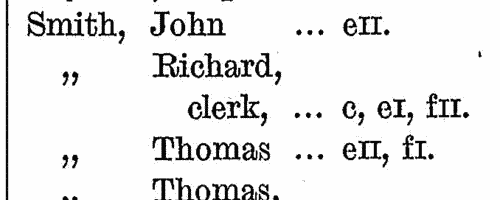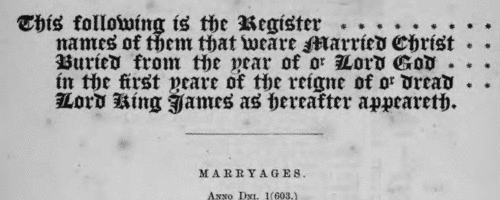Our indexes include entries for the spelling brathwaite. In the period you have requested, we have the following 108 records (displaying 41 to 50):
Inhabitants of Hertfordshire
(1702-1732)
These people signed various rolls at Hertford, mainly concerning allegiance. The letters are the key to the rolls involved:
a. Oaths of allegiance, supremacy and abjuration under an Act of 1 George I: 1727 to 1732;
b. Oaths of allegiance, supremacy and abjuration under an Act of 6 Anne: 25 April 1715;
c. Oaths of allegiance, supremacy and abjuration under an Act of 6 Anne: 21 August 1714 to 21 April 1718;
d. Oath for naturalizing Foreign Protestants under Act of 7 Anne: 10 May to 15 August 1719;
e. Oath of allegiance under Act of 1 Anne: I. 13 July 1702 to 19 July 1714; II. 13 July 1702 to 19 February 1709; III. 13 July 1702 to 8 October 1708;
f. Declaration against Transubstantiation, under Act of 1 William & Mary: I. 13 July 1702 to 9 January 1710; II. 12 July 1714 to 21 April 1718; III. 25 April 1715; IV. 10 July 1727 to 17 April 1732. | Sample scan, click to enlarge

|
 Masters and Apprentices
(1738) Masters and Apprentices
(1738)
Apprenticeship indentures and clerks' articles were subject to a 6d or 12d per pound stamp duty: the registers of the payments usually give the master's trade, address, and occupation, and the apprentice's father's name and address, as well as details of the date and length of the apprenticeship. 1 January to 7 October 1738 | Sample scan, click to enlarge

|
 Masters and Apprentices
(1744) Masters and Apprentices
(1744)
Apprenticeship indentures and clerks' articles were subject to a 6d or 12d per pound stamp duty: the registers of the payments usually give the master's trade, address, and occupation, and the apprentice's father's name and address, as well as details of the date and length of the apprenticeship. | Sample scan, click to enlarge

|
 Apprentices registered at Durham
(1741-1745) Apprentices registered at Durham
(1741-1745)
Apprenticeship indentures and clerks' articles were subject to a 6d or 12d per pound stamp duty: the registers of the payments usually give the master's trade, address, and occupation, and the apprentice's father's name and address, as well as details of the date and length of the apprenticeship. There are central registers for collections of the stamp duty in London, as well as returns from collectors in the provinces. These collectors generally received duty just from their own county, but sometimes from further afield. (The sample entry shown on this scan is taken from a Norfolk return) | Sample scan, click to enlarge

|
 Masters and Apprentices
(1746) Masters and Apprentices
(1746)
Apprenticeship indentures and clerks' articles were subject to a 6d or 12d per pound stamp duty: the registers of the payments usually give the master's trade, address, and occupation, and the apprentice's father's name and address, as well as details of the date and length of the apprenticeship. 1 January to 3 October 1746 | Sample scan, click to enlarge

|
 Masters and Apprentices
(1747) Masters and Apprentices
(1747)
Apprenticeship indentures and clerks' articles were subject to a 6d or 12d per pound stamp duty: the registers of the payments usually give the master's trade, address, and occupation, and the apprentice's father's name and address, as well as details of the date and length of the apprenticeship. | Sample scan, click to enlarge

|
Wandsworth Brides
(1747)
The ancient parish of Wandsworth in Surrey comprised the single township of Wandsworth, including the hamlets of Garratt, Half Farthing and Summers Town. It lay in the archdeaconry of Surrey of the diocese of Winchester: unfortunately, few bishop's transcripts of Surrey parish registers survive earlier than 1800. Although the original parish registers of Wandsworth doubtless commenced in 1538, the volume(s) before 1603 had been lost by the 19th century. In 1889 a careful transcript by John Traviss Squire of the first three surviving registers was printed, and we have now indexed it year by year. The marriage registers rarely give more information than the date of the wedding, and the names of bride and groom. From 1662 onwards it was normally indicated whether a marriage was by banns or by licence. Surrey archdeaconry marriage bonds &c. survive from 1674 onwards. | Sample scan, click to enlarge

|
 Masters of Apprentices registered at Liverpool in Lancashire
(1750-1754) Masters of Apprentices registered at Liverpool in Lancashire
(1750-1754)
Apprenticeship indentures and clerks' articles were subject to a 6d or 12d per pound stamp duty: the registers of the payments usually give the master's trade, address, and occupation, and the apprentice's father's name and address, as well as details of the date and length of the apprenticeship. There are central registers for collections of the stamp duty in London, as well as returns from collectors in the provinces. These collectors generally received duty just from their own county, but sometimes from further afield. (The sample entry shown on this scan is taken from a Norfolk return) | Sample scan, click to enlarge

|
 Apprentices
(1757) Apprentices
(1757)
Apprenticeship indentures and clerks' articles were subject to a 6d or 12d per pound stamp duty: the registers of the payments usually give the master's trade, address, and occupation, and the apprentice's name, as well as details of the date and length of the apprenticeship. 1 January to 31 December 1757. | Sample scan, click to enlarge

|
 Masters of Apprentices
(1758) Masters of Apprentices
(1758)
Apprenticeship indentures and clerks' articles were subject to a 6d or 12d per pound stamp duty: the registers of the payments usually give the master's trade, address, and occupation, and the apprentice's name, as well as details of the date and length of the apprenticeship. 1 January to 31 December 1758. | Sample scan, click to enlarge

|
Research your ancestry, family history, genealogy and one-name study by direct access to original records and archives indexed by surname.












